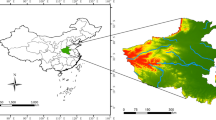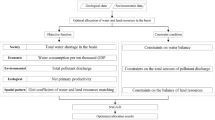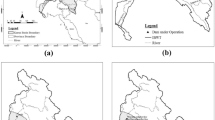Abstract
To promote the harmonious development of human and water resources, the scarcity and ecological value of water resources should be considered in water resource allocation. In this paper, synergetic theory was applied to the process of water resource allocation, and we constructed a synergetic theory-based water resource allocation model by investigating the synergetic principle of each link of water resource allocation. The objective equation was established for determining the optimal comprehensive benefit of the composite system. Multidimensional constraint conditions were constructed from the perspective of the social benefit, economic benefit and ecological benefit of water supply, and balance equations were established. Order parameters were selected for the social, economic and ecological subsystems, and the order degrees of the three subsystems and the synergetic degrees of allocation schemes were calculated by using the fuzzy mathematics method to provide a basis for the recommendation of an optimal scheme. Finally, we proposed a multicycle iterative algorithm to realize the overall objective of “harmonious development between humans and water resources”, which provides an effective calculation tool for water resource synergetic allocation. This model was applied in Jilin, and an optimal scheme was recommended on the basis of a synergetic degree analysis, which shows that the water supply of conventional water sources will be saved by an increase in the reclaimed water supply. In addition, after the implementation of an external diversion project by 2030, the amount of groundwater withdrawal will be gradually reduced, and the water deficit rate will be significantly reduced.











Similar content being viewed by others
Data Availability
Not applicable, The data sets supporting the results of this article were described in the ‘3.1 Study Area and Data’ part.
Code Availability
Not applicable.
References
Abolpour B, Javan M, Karamouz M (2007) Water Allocation Improvement in River Basin using Adaptive Neural Fuzzy Reinforcement Learning Approach. Appl Soft Comput 7:265–285. https://doi.org/10.1016/j.asoc.2005.02.007
Castañer CM, Bellver-Domingo Á, Hernández-Sancho F (2020) Environmental and Economic Approach to Assess a Horizontal Sub-Surface Flow Wetland in Developing Area. Water Resour Manag 34:3761–3778. https://doi.org/10.1007/s11269-020-02629-x
Chang FJ, Wang YC, Tsai WP (2016) Modelling Intelligent Water Resources Allocation for Multi-Users. Water Resour Manag 30:1395–1413. https://doi.org/10.1007/s11269-016-1229-6
Chen X, Chen Y, Lai G (2002) Study on Optimal Allocation of Water Resources in Dongjiang River Basin. J Nat Resour 3:366–372
Dadmand F, Naji-Azimi Z, Farimani NM, Davary K (2020) Sustainable Allocation of Water Resources in Water-Scarcity Conditions using Robust Fuzzy Stochastic Programming. J Clean Prod 276:123812. https://doi.org/10.1016/j.jclepro.2020.123812
Dai C, Qin XS, Chen Y, Guo HC (2018) Dealing with Equality and Benefit for Water Allocation in a Lake Watershed: A Gini-Coefficient Based Stochastic Optimization Approach. J Hydrol 561:322–334. https://doi.org/10.1016/j.jhydrol.2018.04.012
Das B, Singh A, Panda SN, Yasuda H (2015) Optimal Land and Water Resources Allocation Policies for Sustainable Irrigated Agriculture. Land Use Policy 42:527–537. https://doi.org/10.1016/j.landusepol.2014.09.012
de Lange WJ, Wise RM, Forsyth GG, Nahman A (2010) Integrating Socio-Economic and Biophysical Data to Support Water Allocations within River Basins: An Example from the Inkomati Water Management Area in South Africa. Environ Model Softw 25:43–50. https://doi.org/10.1016/j.envsoft.2009.06.011
Dehaghi BF, Khoshfetrat A (2020) Optimal Allocation of Water Reuse using Modified Todim-Gp Approach with Considering the Leopold Matrix Outputs. Water Resour Manag 34:3823–3854. https://doi.org/10.1007/s11269-020-02646-w
Gui M (2001) The Research on Several Problems of Ecology, Economy and Society Based on the Human Social Synergy Theory. Jiangxi People's Publishing House, China
Guo Z, Shen X (1991) Synergetic Theory. Shanxi Economics Publishing House, China
Kicsiny R, Varga Z (2019) Differential Game Model with Discretized Solution for the Use of Limited Water Resources. J Hydrol 569:637–646. https://doi.org/10.1016/j.jhydrol.2018.12.029
Kralisch S, Fink M, Flügel WA, Beckstein C (2003) A Neural Network Approach for the Optimisation OF Watershed Management. Environ Model Softw 18:815–823. https://doi.org/10.1016/s1364-8152(03)00081-1
Kucukmehmetoglu M (2012) An Integrative Case Study Approach between Game Theory and Pareto Frontier Concepts for the Transboundary Water Resources Allocations. J Hydrol 450-451:308–319. https://doi.org/10.1016/j.jhydrol.2012.04.036
Lei H, Huang B, Qiu J et al (2017) Comprehensive Evaluation of Water Resources Allocation Based on Synergetic Theory. Guangdong Water Resour Hydropower 3:1–5
Li Z, Li C, Wang X, Peng C, Cai Y, Huang W (2018) A Hybrid System Dynamics and Optimization Approach for Supporting Sustainable Water Resources Planning in Zhengzhou City, China. J Hydrol 556:50–60. https://doi.org/10.1016/j.jhydrol.2017.11.007
Li X, Wang X, Guo H, Ma W (2020) Multi-Water Resources Optimal Allocation Based on Multi-Objective Uncertain Chance-Constrained Programming Model. Water Resour Manag 34:4881–4899. https://doi.org/10.1007/s11269-020-02697-z
Liqin L, Chuanjiang W, Xinmin X, Xueyi W (2015) An Optimal Water Allocation Model Based on “Water- Economy” Gini Coefficient In Urban Agglomeration. In: 2015 Seventh International Conference on Measuring Technology and Mechatronics Automation. IEEE, Nanchang, pp 128–132
Liu B, Chen X (2009) Water Resources Deployment Model for River Basin Based on Synergetic Theory. J Water Conserv 40:60–66
Liu G, Zhang Y, Wang Y (2010) Study on Groundwater Recharge and Optimal Allocation of Water Resources in Inner Mongolia Twin Well Irrigation Area. J Arid Land Resour Environ 2:62–68
Mahan RC, Horbulyk TM, Rowse JG (2002) Market Mechanisms and the Efficient Allocation of Surface Water Resources in Southern Alberta. Socio-Econ Plan Sci 36:25–49. https://doi.org/10.1016/s0038-0121(01)00013-1
Mianabadi H, Mostert E, Zarghami M, van de Giesen N (2014) A New Bankruptcy Method for Conflict Resolution in Water Resources Allocation. J Environ Manag 144:152–159. https://doi.org/10.1016/j.jenvman.2014.05.018
Minsker BS, Padera B, Smalley JB (2000) Efficient Methods for Including Uncertainty and Multiple Objectives in Water Resources Management Models using Genetic Algorithms. In: Bentley LR, Sykes JF, Brebbia CA, Gray WG, Pinder GF, Bentley LR, Sykes JF, Brebbia CA, Gray WG, Pinder GF (eds) Computational Methods in Water Resources - Volume 1 - Computational Methods for Subsurface Flow and Transport. A.A.Balkema, Calgary, pp 25–29
Nasiri-Gheidari O, Marofi S, Adabi F (2018) A Robust Multi-Objective Bargaining Methodology for Inter-Basin Water Resource Allocation: A Case Study. Environ Sci Pollut Res 25:2726–2737. https://doi.org/10.1007/s11356-017-0527-8
Pei Y, Zhao Y, Zhang J (2007) The Theory of Rational Allocation of Generalized Water Resources. J Water Conserv 38:1–7
Perera BJC, James B, Kularathna MDU (2005) Computer Software Tool Realm for Sustainable Water Allocation and Management. J Environ Manag 77:291–300. https://doi.org/10.1016/j.jenvman.2005.06.014
Pourmand E, Mahjouri N (2018) A Fuzzy Multi-Stakeholder Multi-Criteria Methodology for Water Allocation and Reuse in Metropolitan Areas. Environ Monit Assess 190:444. https://doi.org/10.1007/s10661-018-6813-1
Pourmand E, Mahjouri N, Hosseini M, Nik-Hemmat F (2020) A Multi-Criteria Group Decision Making Methodology using Interval Type-2 Fuzzy Sets: Application to Water Resources Management. Water Resour Manag 34:4067–4092. https://doi.org/10.1007/s11269-020-02657-7
Qin J, Fu X, Peng S (2020) Asymmetric Benefit Compensation Model for Resolving Transboundary Water Management Conflicts. Water Resour Manag 34:3625–3647. https://doi.org/10.1007/s11269-020-02639-9
Rosegrant MW, Ringler C, McKinney DC, Cai X, Keller A, Donoso G (2000) Integrated Economic-Hydrologic Water Modeling at the Basin Scale: The Maipo River Basin. Agric Econ 24:33–46. https://doi.org/10.1111/j.1574-0862.2000.tb00091.x
Sarband EM, Araghinejad S, Attari J (2020) Developing an Interactive Spatial Multi-Attribute Decision Support System for Assessing Water Resources Allocation Scenarios. Water Resour Manag 34:447–462. https://doi.org/10.1007/s11269-019-02291-y
Sethi LN, Panda SN, Nayak MK (2006) Optimal Crop Planning and Water Resources Allocation in a Coastal Groundwater Basin, Orissa, India. Agric Water Manag 83:209–220. https://doi.org/10.1016/j.agwat.2005.11.009
Tian J, Guo S, Liu D, Pan Z, Hong X (2019) A Fair Approach for Multi-Objective Water Resources Allocation. Water Resour Manag 33:3633–3653. https://doi.org/10.1007/s11269-019-02325-5
Wang H, Chen M, Qin D (2003) Study on the Reasonable Allocation and Carrying Capacity of Water Resources in Northwest China. Yellow River Conservancy Press, Zhengzhou
Wang T, Liu Y, Wang Y, Xie X, You J (2019) A Multi-Objective and Equilibrium Scheduling Model Based on Water Resources Macro Allocation Scheme. Water Resour Manag 33:3355–3375. https://doi.org/10.1007/s11269-019-02304-w
Wei C, Han J, Han H (2012) Key Technologies and Demonstrations for Tfp Optimization in River Basin. China Water Resources and Hydropower Press, China
Wu M, Ge W, Wu Z, Guo X, Di D, Huang S (2020) Evaluation of the Benefits of Urban Water Resource Utilization Based on the Catastrophe and Emergy Methods. Water Resour Manag 34:1843–1853. https://doi.org/10.1007/s11269-020-02530-7
Xie X, Guo H, Tang K et al (2002) Study on the Dual Coupling Model for the Unified Evaluation of Surface Water and Groundwater in the North China Plain. J Water Conserv 12:95–100
Yao N, Chen F, Gan S, Hu C (2017) Application of Synergetics in Evaluation of Sustainable Water Resources Utilization. J China Hydrol 37:29–33
Zaman AM, Malano HM, Davidson B (2009) An Integrated Water Trading–Allocation Model, Applied to a Water Market in Australia. Agric Water Manag 96:149–159. https://doi.org/10.1016/j.agwat.2008.07.008
Zeng Y, Li J, Cai Y, Tan Q (2017) Equitable and Reasonable Freshwater Allocation Based on a Multi-Criteria Decision Making Approach With Hydrologically Constrained Bankruptcy Rules. Ecol Indic 73:203–213. https://doi.org/10.1016/j.ecolind.2016.08.049
Zhao Y (2006) Study on Rational Allocation of Generalized Water Resources. China Institute of Water Resources and Hydropower Research
Acknowledgements
The writers also acknowledge the assistance of anonymous reviewers.
Funding
The work is supported by the Ningxia Key Research and Development Program (Special Talents) (Grant No. 2019BEB04029), the Natural Science Foundation of Ningxia University (Grant No. ZR18018), the Natural Science Foundation of Ningxia (Project approved in 2021), the First-class Discipline Construction Project of Ningxia University (Grant No. NXYLXK2017A03), the National Key R&D Program of China (Grant No. 2017YFC0404306), the National Nature Science Foundation of China (Grant No. 51709274, 51809143, 51869023), the Training Project for the Top Young Talents in Ningxia (Grant No. 030103030008), and the Research Initiative Fund of Ningxia University.
Author information
Authors and Affiliations
Contributions
All authors contributed to the study conception and design. Material preparation, data collection and analysis were performed by Xiaojing Shen, Xu Wu and Xinmin Xie. The first draft of the manuscript was written by Xiaojing Shen. Software was performed by Xu Wu and Chuanjiang Wei, Editing and visualization were performed by Liqin Li and Jingjing Zhang. All authors commented on previous versions of the manuscript, and authors read and approved the final manuscript.
Corresponding author
Ethics declarations
Ethical Approval
Not applicable.
Consent to Participate
Not applicable.
Consent to Publish
The authors confirm that the work described has not been published before, and not under consideration for publication elsewhere. Its publication has been approved by all co-authors, and we agree to publish this article in the journal of WARM by Springer.
Conflict of Interest
None.
Additional information
Publisher’s Note
Springer Nature remains neutral with regard to jurisdictional claims in published maps and institutional affiliations.
Rights and permissions
About this article
Cite this article
Shen, X., Wu, X., Xie, X. et al. Synergetic Theory-Based Water Resource Allocation Model. Water Resour Manage 35, 2053–2078 (2021). https://doi.org/10.1007/s11269-021-02766-x
Received:
Accepted:
Published:
Issue Date:
DOI: https://doi.org/10.1007/s11269-021-02766-x




